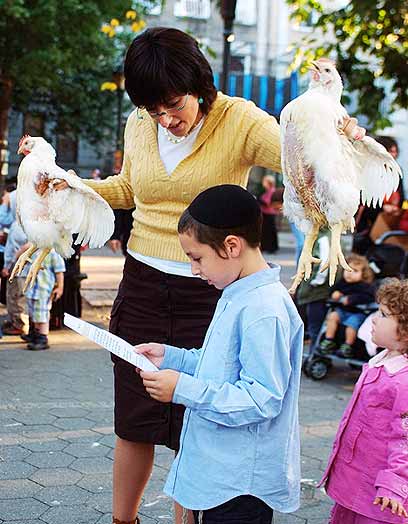Yesterday was a nice day. It was a good opportunity for me to gather a few extra good deeds before Yom Kippur, without the humidity getting in the way of my intentions. I knocked on my friend’s door full of determination. She opened the door out of breath, and moved back to make room for her eight-month-pregnant belly.
“I’m taking everyone to the park,” I declared, probably satisfying her greatest dream. I loaded the two little ones in the double stroller, and with my little one holding on nicely we all walked leisurely towards the park.
Something smelt off long before we got there. The green park usually welcomes us with the aroma of rosemary and sage, but now it reeked of the sour smell of rotting garbage. Unfortunately, I did not realize quickly enough what was going on, although the smell and the calendar date should have been enough of a hint, and I stepped right into the worst pandemonium, with children and feathers all over the place.
Kapparot is a custom performed on the eve of Yom Kippur in which a person atones for their sins. It is performed by grasping a live chicken, or money, and moving it around one's head three times, symbolically transferring one's sins to the chicken. The chicken is later slaughtered and given to the poor, as is the money. The word kapparot, or in the singular form kappara, also means "beloved" in Hebrew slang.
My late grandmother would use the word kapparot at least twice a day. This grandmother had transformed the biblical David’s "would I have died for thee" into an art of self-sacrifice. When she would say "I love you to death," she meant it, literally. But when she said "kapparot" I am quite sure she was not referring to chickens in the sandbox and terrified children in the streets.
Once upon a time, rabbis and pious Jews would take the kapparot chicken, look it deep in the eyes with trepidation and enter a meditative state, changing places with the chicken and assuming its entity as coq-au-vin. When reciting the ceremonial words "this is my exchange, this is my substitute, this is my atonement" you should be immersed in the meaning of the words.

Kapparot in Brooklyn (Photo: Yisrael Bardugo)
If you are preoccupied with the chicken being too close to your head when you should actually be at one with the chicken and fully aware that it is your flesh that should be slaughtered, then… Never mind... You get my point.
In all honesty, I cannot understand how you can be absorbed in anything when you see how the tradition has turned into a festival for the whole family, including a little petting zoo.
The hens and roosters are held in appalling conditions, and some of them are not fed or watered. And you are a part of all this, with an extra new sin for the New Year – cruelty to animals. When you see people so happy and cheerful a moment after they have allegedly sent themselves to slaughter, something smells fowl… oops, I meant foul.
Do I oppose the use of chickens for the tradition? There are, after all, alternative traditions. The answer is "no," although my friends from the animal-rights movement will not be pleased with my answer. I am also no longer an avid vegetarian and they don’t like that either, but c’est la vie.
Kapparot is not voodoo. It is not about beheading. The chickens are slaughtered in the end for food, and not for the sake of killing. The final act is not even part of the actual ceremony itself. It was also not intended to be performed in the park with hundreds of children around, but in the privacy of the slaughterhouse. It is not supposed to cause the animals any suffering, and when it does, it is totally unnecessary.
It can be done differently
I once saw a real kapparot ceremony. A truly righteous man grew the birds in his back yard. He fed them, watered them and raised them with love.During the ceremony, his hand trembled as he gently held the chicken and moved it around his head. When he said “Children of man, who sat in darkness and the shadow of death…” – traditionally recited before the ceremony – it was quite clear to whom he was referring. He cried, and his tears dropping onto his prayer book distorted the words. It was a thrilling, heartbreaking experience.
Unfortunately, that is the difference between charity and atonement. Spinning a bag with the traditional sum of NIS 18 over your head just doesn’t cut it. I do not think that anyone believes that they can redeem their life for such small a sum. That is a joke. We give much more than that in standing orders throughout the year.
Whether your tradition is to perform the kapparot ceremony with money, a fish or a chicken, what is important is the "kavana," the intent: to really and truly believe that after the bad things that we have done (and everyone has some baggage) we are not worthy of the life we are given as a daily gift. Maybe we need to work harder at becoming more worthy.
Remember that when the fishmonger gives the fish the final blow to its head, when we give the money to the poor to redeem our own life and when the slaughterer slits the chicken’s throat, that should have been us. Someone up in the heavens needs to see that we are truly sorry and that we want a fresh start. The fact that we are still around and breathing is only a sad optical illusion, but we regret everything we have done. We promise that from now we will be better, more worthy of the life given us and that this will be the kappara, redemption, in exchange for a better life and peace.















